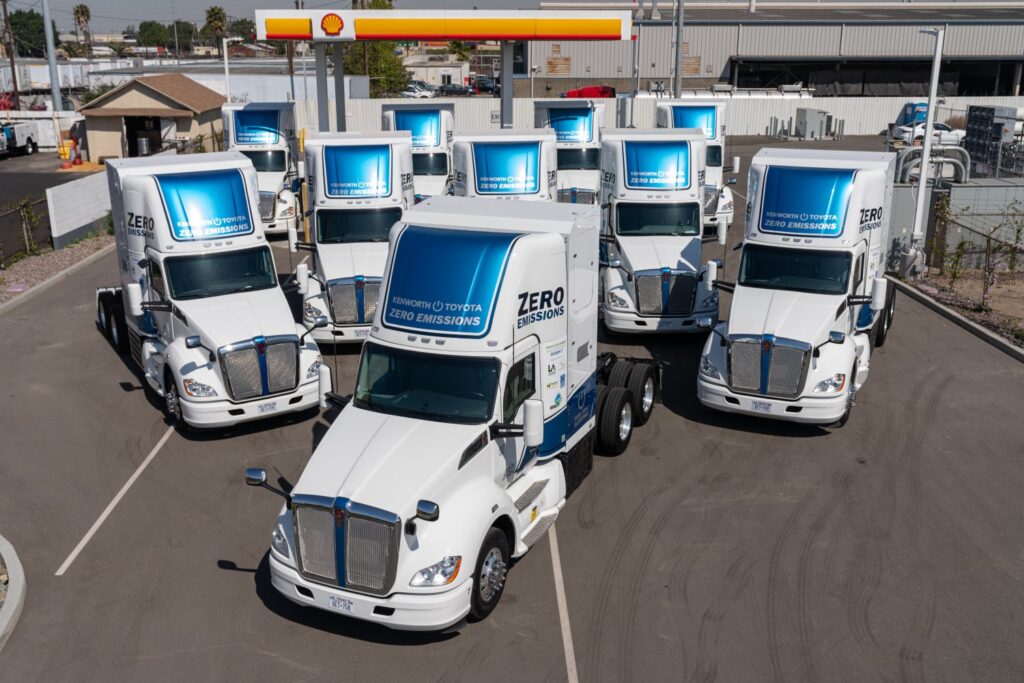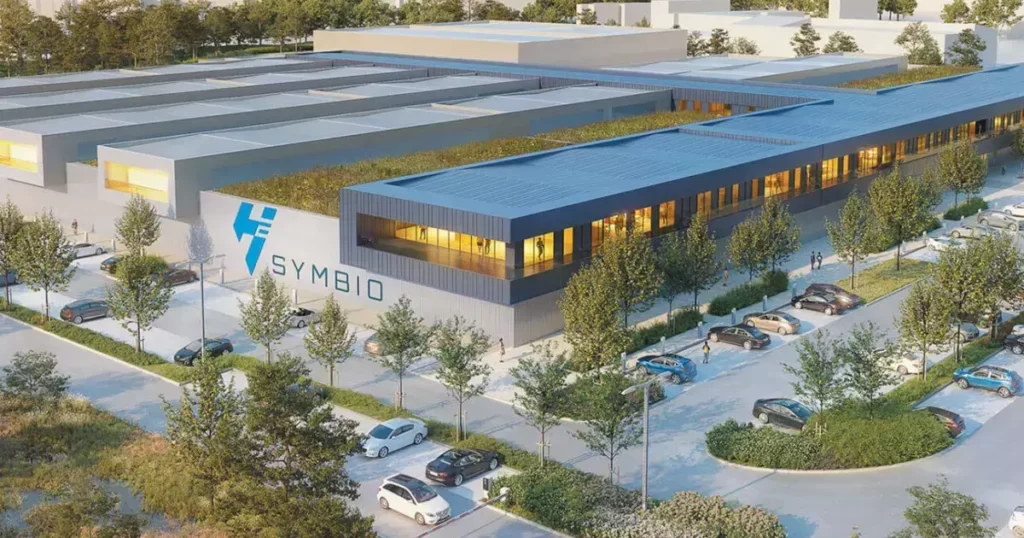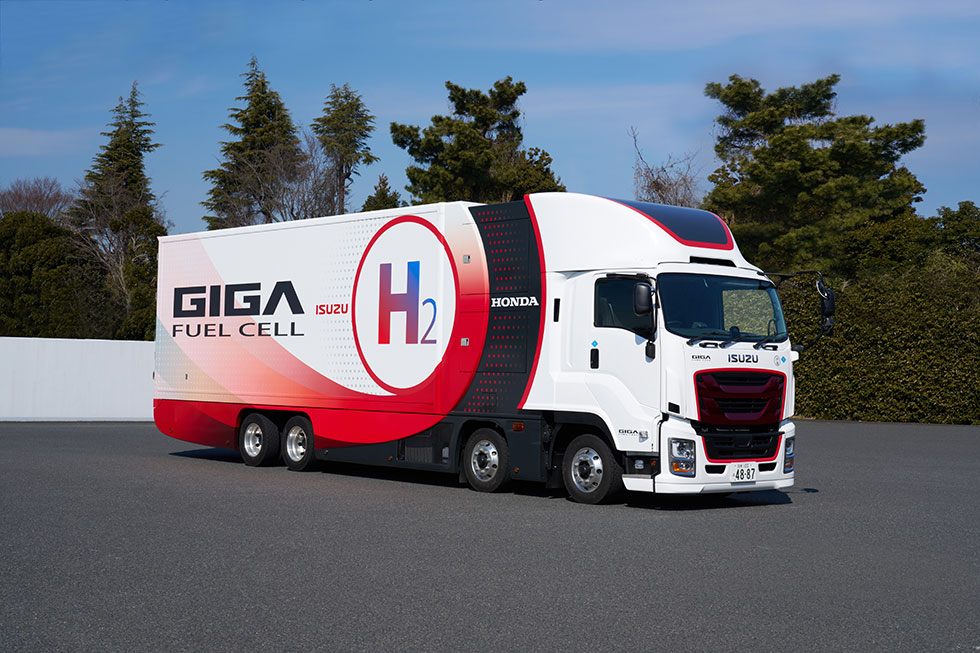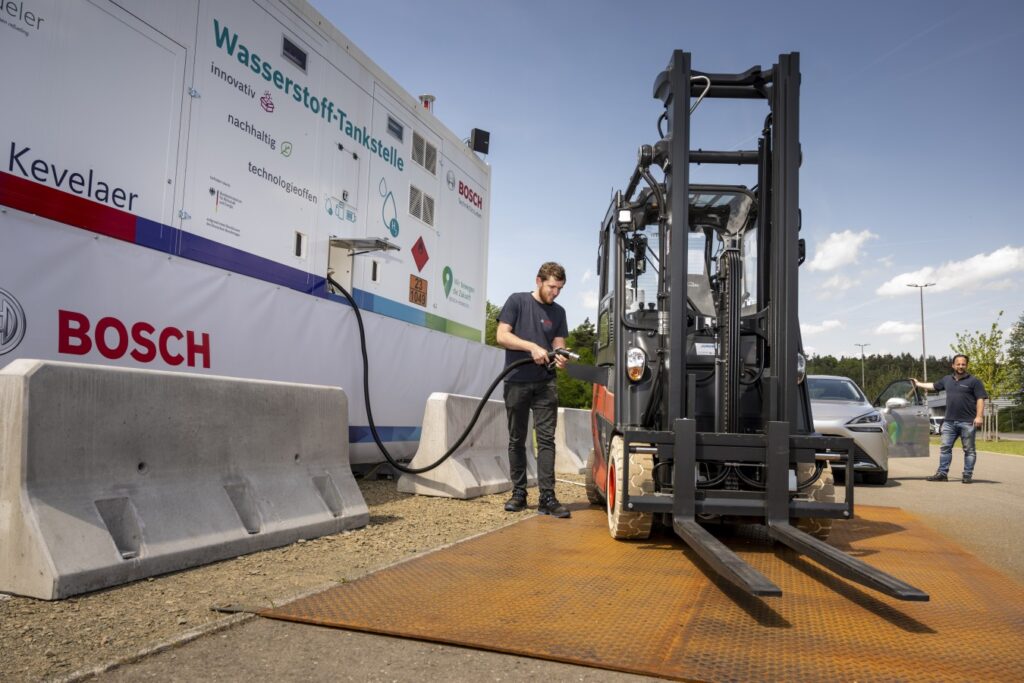Hydrogen-fuelled transport back on the agenda
- PostedPublished 10 October 2023
A recent swathe of activity within the automotive industry suggests that hydrogen, as an energy source, is becoming more widely accepted as an addition to support battery electric vehicles (BEVs) and meet forthcoming emissions targets.
Following a period of fence-sitting on – and even abandoning – hydrogen projects, established manufacturers are now collaborating to develop hydrogen-fuelled internal combustion engines and fuel cell electric vehicles (FCEVs), with global market share projected to grow from A$2.28 billion in 2022 to A$95.02 billion by 2032.
Toyota and Kenworth: The future of green trucking?

The Kenworth T680 FCEV features Toyota’s hydrogen fuel cell powertrain kit, which uses compressed hydrogen and oxygen from the air to generate electricity inside a fuel cell stack to power an electric drivetrain. It offers truckers a range of 560 km with just a 15-minute refuelling time, and it was recently at the Brisbane Truck Show.
This kit is part of Toyota and Kenworth’s partnership aimed at offering truckers an environmentally-friendly solution that does away with the slow charging limitations of an all-electric truck. Since its recent approval as a zero-emission powertrain by Californian authorities, the kit can now be used as a swap-out or as-new on Class 8 heavy vehicles. It consists of hydrogen fuel storage tanks, fuel cell stacks, batteries, electric motors, and a transmission.
“We believe hydrogen will play a significant role in the emissions reduction of heavy-duty transport while not sacrificing the distance, power or fuelling times needed to keep these fleet and individual operators running,” says Chris Rovik, executive program manager in Toyota Motor North America’s advanced mobility division.
Prior to approval, the 10 prototype T680 FCEV trucks transported shipping containers between the Port of Los Angeles and Long Beach, and in an effort to prove the technology’s worth, one tuck even conquered the Pikes Peak Hill Climb, part of the Rocky Mountains in Colorado, climbing 1440m from the start to 4302m at the finish, with grades averaging 7.2 per cent but up to 20 per cent.
Stellantis, Michelin, Faurecia and Symbio: Joint-venture hydrogen bet!

Stellantis has struck an AU$244 million deal to buy an equal one-third ownership stake in Symbio, a leader in zero-emission hydrogen mobility, with existing partners Michelin and Faurecia.
In 2021, Stellantis introduced its first hydrogen-powered mid-size vans from Citroen, Opel, and Peugeot. In 2024 and 2025, the company plans to deliver large vans as well as heavy-duty vehicles that run on hydrogen.
Symbio’s HyMotive project intends to accelerate its industrialisation and the development of disruptive innovations at its cutting-edge Saint-Fons factory, which will begin production in the second half of 2023 with the goal of producing 50,000 fuel cells annually by 2025. By 2028, Symbio expects to have a total annual production capacity of 100,000 systems.
“Acquiring an equal stake in Symbio will bolster our leadership position in hydrogen-powered vehicles by supporting our fuel cell van production in France, and it also serves as a perfect complement to our growing battery electric vehicle portfolio,” said Stellantis CEO Carlos Tavares.
Isuzu and Honda: Heavy-duty tie-up aims to meet net-zero targets

Truck specialist Isuzu has partnered with Honda, a pioneer in hydrogen-powered cars, to create and provide fuel-cell systems for FCEV heavy-duty trucks that will debut in 2027. The complementing skills of these partners will aid the development of quiet, low-vibration hydrogen-powered trucks.
“Although we have done extensive R&D into passenger FCVs (fuel cell vehicles), we have not been able to study how best to apply the technology to commercial vehicles,” a Honda spokesperson told reporters in 2020. “This partnership will allow us to do that.”
Both manufacturers agree that fuel cell technology, which creates no direct CO2 emissions, is the best solution for reaching their carbon reduction targets whilst also dealing with the issues of large payloads, extended use, long-distance travel, and the need for quick refuelling.
The pair are currently at the testing and validation stage, using an Isuzu-built Giga prototype truck running Honda’s fuel cell powertrain, which has approval for use on public roads in Japan.
Honda, Kawasaki, Suzuki, and Yamaha: Hydrogen-powered motorcycle engines and more!

An association of four major motorcycle manufacturers is looking to use hydrogen as a fuel to power the internal combustion engine (ICE).
Honda, Kawasaki, Suzuki, and Yamaha are in agreement that they must address climate concerns with a variety of future options rather than putting all of their resources, time, and money into one alternative fuel solution, such as battery electric power, which lacks the excitement, sound, smell, and sensation that combustion engines bring to the motorcycle ownership experience.
The association has recently received approval from Japan’s Ministry of Economy, Trade, and Industry to form a research group called HySE (Hydrogen Small Mobility & Engine Technology).
Compatriot Toyota, with its deep well of expertise in hydrogen fuel systems, will also provide additional support.
The aim is to develop the use of hydrogen as a gaseous or liquid fuel that is fed into an internal combustion engine for small applications and establish a design standard. Each member of the research group will focus on a different role in the ongoing studies, which include functionality, performance, reliability, and refuelling.
Yamaha has already cooperated with Toyota and Lexus on a number of hydrogen combustion engine prototypes, so it is in a good position to exploit this next-generation energy source.
“We are extremely pleased to announce the planned formation of the association,” said chairman nominee of HySE, Kenji Komatsu. “There are many challenges in the development of hydrogen-powered engines, but we hope to see the association’s activities advance the fundamental research in order to meet those challenges.”
“However, the use of hydrogen poses technical challenges, including fast flame speed and a large region of ignition, which often result in unstable combustion, and the limited fuel tank capacity in case of use in small mobility vehicles,” Kenji Komatsu said.
Kawasaki recently showcased a concept of its supercharged Ninja H2 at the Milan Motorcycle Show, suggesting it would make an ideal candidate for a hydrogen-powered motorcycle since forced induction is a crucial element.
Hydrogen engines require roughly three times as much air as their petrol equivalents because they require a different fuel/air ratio. Interestingly, the Ninja’s fuel cylinders were carried in a pair of side panniers.
Bosch and Maximator: Hydrogen filling stations. Where are the pumps?

Let’s not ignore the obvious: A lack of hydrogen filling stations remains one of the largest hurdles for the fuel. For example, compared to Australia which has just two public hydrogen stations, proactive California has 60, of which only a handful cater to trucks.
However, there is hope on the horizon. Automotive supplier Bosch – which became carbon-neutral in 2020 – has teamed up with Maximator, a manufacturer of hydrogen filling stations.
Together, they have developed a solution for the efficient compression of hydrogen, which, when combined with container-based hydrogen systems, provides a scalable, low-cost solution for forecourt owners venturing into the supply of hydrogen. By 2030, Bosch and Maximator hope to have 4000 of these stations up and running worldwide.
“On the path to a climate-neutral future, we have to make it possible for energy-intensive industries to shift to renewables. Hydrogen will be a key element in security of supply,” said Bosch manufacturing technology chief Rolf Najork.
- CategoriesIn SightGlass
- TagsHydrogen, hydrogen fuel cell, hydrogen internal combustion, hydrogen trucks, SightGlass News Issue 29

